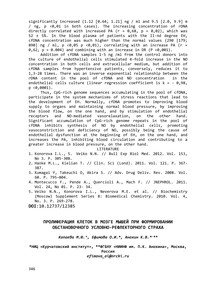ПРОЛИФЕРАЦИЯ КЛЕТОК В МОЗГЕ МЫШЕЙ ПРИ ФОРМИРОВАНИИ ОБСТАНОВОЧНОГО УСЛОВНО-РЕФЛЕКТОРНОГО СТРАХА
Покупка
Основная коллекция
Тематика:
Медикобиологические дисциплины
Издательство:
НИЦ ИНФРА-М
Год издания: 2015
Кол-во страниц: 5
Дополнительно
Тематика:
ББК:
УДК:
ГРНТИ:
Скопировать запись
Фрагмент текстового слоя документа размещен для индексирующих роботов
significantly increased (1.12 [0.64; 1.21] ng / ml and 9.5 [2.0, 9.9] m / ng, p <0,01 in both cases). The increasing concentration of rDNA directly correlated with increased PA (r = 0,68, p = 0,02), which was 52 ± 5%. In the blood plasma of patients with the II-nd degree EH, cfDNA concentration was much higher than the normal values (290 [179; 890] ng / ml, p <0,05 p <0,01), correlating with an increase PA (r = 0,62, p = 0.004) and combining with an increase in DR (P <0,001). Addition of cfDNA samples 1-5 ng /ml from the control donors into the culture of endothelial cells stimulated 4-fold increase in the NO concentration in both cells and extracellular medium, but addition of cfDNA samples from hypertensive patients, conversely, reduces it to 1,3-28 times. There was an inverse exponential relationship between the rDNA content in the pool of cfDNA and NO concentration in the endothelial cells culture (linear regression coefficient is k = - 0,98, p <0,0001). Thus, CpG-rich genome sequences accumulating in the pool of cfDNA, participate in the system mechanisms of stress reactions that lead to the development of EH. Normally, cfDNA promotes to improving blood supply to organs and maintaining normal blood pressure, by improving the blood flow, on the one hand, and by stimulation of endothelial receptors and NO-mediated vasorelaxation, on the other hand. Significant accumulation of CpG-rich genome repeats in the pool of cfDNA inhibits synthesis of NO by endothelial cells, promoting vasoconstriction and deficiency of NO, possibly being the cause of endothelial dysfunction at the beginning of EH, on the one hand, and increases the PA, inhibiting blood circulation and contributing to a greater increase in blood pressure, on the other hand. LITERATURE 1. Konorova I.L., 5. Veiko N.N. // Bull Exp Biol Med. 2012. Vol. 153, No 3. P. 305-308. 2. Hanke M.L., Kielian T. // Clin. Sci (Lond). 2011. Vol. 121. P. 367 387. 3. Kumagai Y, Takeuchi O, Akira S. // Adv. Drug Deliv. Rev. 2008. Vol. 60. P. 795–804. 4. Montecucco F., Pende A., Quercioli A., Mach F. // JNEPHROL. 2011. Vol. 24, No 01. P. 23- 34. 5. Veiko N.N., Konorova I.L., Neverova M.E. et al. // Biochemistry (Moscow) Supplement Series B: Biomedical Chemistry. 2010. Vol. 4, No. 3. P. 269-278. DOI:10.12737/12385 ПРОЛИФЕРАЦИЯ КЛЕТОК В МОЗГЕ МЫШЕЙ ПРИ ФОРМИРОВАНИИ ОБСТАНОВОЧНОГО УСЛОВНО-РЕФЛЕКТОРНОГО СТРАХА Копаева М.Ю.*, Ефимова О.И.*, Анохин К.В.*,** *НИЦ «Курчатовский институт», **ФГБНУ «НИИНФ им. П.К. Анохина», Москва, Россия efimova_oi@nrcki.ru


